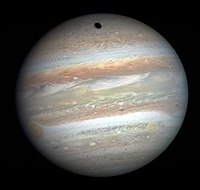
Photo from wikipedia
Abstract We examine the dynamics of small bodies in orbits similar to that of comet 29P/Schwassmann-Wachmann 1, i.e. near-circular orbits between Jupiter and Saturn. As of late 2019, there are… Click to show full abstract
Abstract We examine the dynamics of small bodies in orbits similar to that of comet 29P/Schwassmann-Wachmann 1, i.e. near-circular orbits between Jupiter and Saturn. As of late 2019, there are 14 other known bodies in this region that lie in similar orbits. Previous research has shown that this region of the solar system, which in this work we call the “near Centaur region” (NCR), is not stable, suggesting that any bodies found in it would have very short lifetimes. We performed 20 Myr high-precision numerical simulations of the evolution of massless particles, initially located in the Kuiper belt but close to Neptune, with perihelia slightly below 33 au (“Neptune crossers”). Some of these particles quickly migrate inward, passing through the NCR before becoming Jupiter Family Comets. We find that objects in the NCR do indeed generally travel through it very quickly. However, our simulations reveal that resonant behavior in this region is somewhat common and can trap objects for up to 100 Kyr. We summarize the dynamics of 29P and other observed bodies in the region—two of which seem to be clearly exhibiting resonant behavior—and use our simulations to put limits on the reservoir size of the Neptune crossers, which at its time determines the reservoir size of the Kuiper belt. Finally, we put some constraints on the current population of Centaurs and particularly of the NCR population, based on the injection rates required to keep the observed population of Jupiter family comets in steady-state.
Journal Title: Icarus
Year Published: 2020
Link to full text (if available)
Share on Social Media: Sign Up to like & get
recommendations!